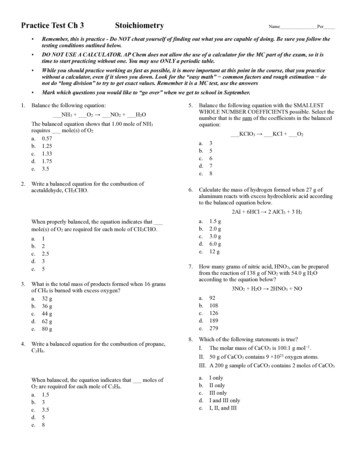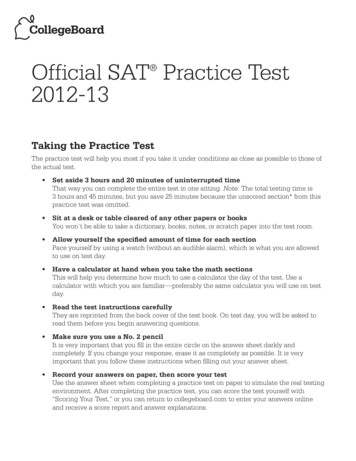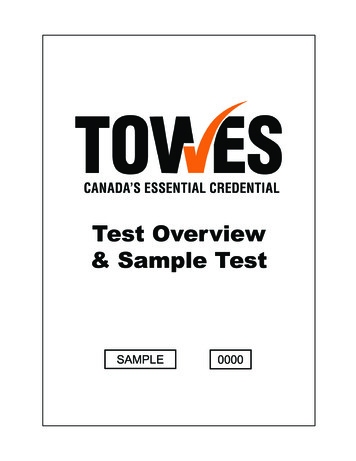
Transcription
Practice Test Ch 31.StoichiometryName Per Remember, this is practice - Do NOT cheat yourself of finding out what you are capable of doing. Be sure you follow thetesting conditions outlined below. DO NOT USE A CALCULATOR. AP Chem does not allow the use of a calculator for the MC part of the exam, so it istime to start practicing without one. You may use ONLY a periodic table. While you should practice working as fast as possible, it is more important at this point in the course, that you practicewithout a calculator, even if it slows you down. Look for the “easy math” common factors and rough estimation donot do “long division” to try to get exact values. Remember it is a MC test, use the answers Mark which questions you would like to “go over” when we get to school in September.Balance the following equation:5.NH3 O2 NO2 H2OThe balanced equation shows that 1.00 mole of NH3requires mole(s) of O2a. 0.57b. 1.25c. 1.33d. 1.75e. 3.52.Write a balanced equation for the combustion ofacetaldehyde, CH3CHO.Balance the following equation with the SMALLESTWHOLE NUMBER COEFFICIENTS possible. Select thenumber that is the sum of the coefficients in the balancedequation:KClO3 KCl O2a.b.c.d.e.6.35678Calculate the mass of hydrogen formed when 27 g ofaluminum reacts with excess hydrochloric acid accordingto the balanced equation below.2Al 6HCl 2 AlCl3 3 H2a.b.c.d.e.When properly balanced, the equation indicates thatmole(s) of O2 are required for each mole of CH3CHO.a.b.c.d.e.3.4.122.5357.What is the total mass of products formed when 16 gramsof CH4 is burned with excess oxygen?a. 32 gb. 36 gc. 44 gd. 62 ge. 80 gWrite a balanced equation for the combustion of propane,C3H8.When balanced, the equation indicates that moles ofO2 are required for each mole of C3H8.a. 1.5b. 3c. 3.5d. 5e. 81.5 g2.0 g3.0 g6.0 g12 gHow many grams of nitric acid, HNO3, can be preparedfrom the reaction of 138 g of NO2 with 54.0 g H2Oaccording to the equation below?3NO2 H2O 2HNO3 NOa.b.c.d.e.8.92108126189279Which of the following statements is true?I. The molar mass of CaCO3 is 100.1 g mol 1.II. 50 g of CaCO3 contains 9 1023 oxygen atoms.III. A 200 g sample of CaCO3 contains 2 moles of CaCO3a.b.c.d.e.I onlyII onlyIII onlyI and III onlyI, II, and III
Practice Test Ch3Stoichiometry2MnO2 4KOH O2 Cl2 2KMnO4 2KCl 2 H2O9.For the reaction above, there is 100. g of each reactantavailable. Which reagent is the limiting reagent?[Molar Masses:MnO2 86.9; KOH 56.1;O2 32.0; Cl2 70.9]a. MnO2b. O2c. KOHd. Cl2e. They all run out at the same time.10. The reaction of 7.8 g benzene, C6H6, with excess HNO3resulted in 0.90 g of H2O. What is the percentage yield?Molar Mass (g/mol):C6H6 78C6H5NO2 123HNO3 63H2O 18(page 2 of 2)14. A given sample of some hydrocarbon is burnedcompletely and it produces 0.44 g of CO2 and 0.27 g ofH2O. Determine the empirical formula of the compound.a. CHb. C2H3c. CH2d. C2H5e. CH315. The simplest formula for a hydrocarbon that is 20.0percent hydrogen by mass isa. CHb. CH2c. CH3d. C2H2e. C2H3C6H6 HNO3 C6H5NO2 H2Oa.b.c.d.e.100%90%50%12%2%11. How many grams of H2O will be formed when 32.0 g H2is allowed to react with 16.0 g O2 according to2 H2 O2 2 H2Oa.b.c.d.e.9.00 g16.0 g18.0 g32.0 g36.0 g12. When 2.00 g of H2 reacts with 32.0 g of O2 in anexplosion, the final gas mixture will contain:a. H2, H2O, and O2b. H2 and H2O onlyc. O2 and H2O onlyd. H2 and O2 onlye. H2O only13. 11.2 g of metal carbonate, containing an unknown metal,M, were heated to give the metal oxide and 4.4 g CO2.MCO3(s) heat MO(s) CO2(g)What is the identity of the metal M?a. Mgb. Pbc. Cad. Bae. Cr16. What mass of Al is produced when 0.500 mole of Al2S3 iscompletely reduced with excess H2?a. 2.7 gb. 13.5 gc. 27.0 gd. 54.0 ge. 108 g17. When a 16.8-gram sample of an unknown mineral wasdissolved in acid, 4.4-grams of CO2 were generated. If therock contained no carbonate other than MgCO3, what wasthe percent of MgCO3 by mass in the limestone?Molar mass (g/mol): MgCO3 84 and CO2 44a. 33%b. 50%c. 67%d. 80%e. 100%18. Which of the following represents the correct method forconverting 11.0 g of copper metal to the equivalentnumber of copper atoms?23 1 6.02 10 a. 11 63.55 1b. 1 11 63.55 c. 1 63.55 11 63.55 6.02 10 23 d.23 63.55 6.02 10 11 1 1e.1 1 11 63.55 6.02 10 23
Practice Test Ch3Stoichiometry19. The mass of element X found in 1.00 mole of each of fourdifferent compounds is 28.0 g, 42.0 g, 56.0 g, and 70 g,respectively. The possible atomic weight of X isa. 8.00b. 14.0c. 28.0d. 38.0e. 42.0N2(g) 2O2(g) N2O4(g)20. The above reaction takes place in a closed flask. Theinitial amount of N2(g) is 8 mole, and that of O2(g) is 12mole. There is no N2O4(g) initially present. Theexperiment is carried out at constant temperature. What isthe total amount of mole of all substances in the containerwhen the amount of N2O4(g) reaches 6 mole?a. 0 moleb. 2 molec. 6 moled. 8 molee. 20 mole21. Given that there are two naturally occurring isotopes ofgallium, 69Ga and 71Ga, the natural abundance of the 71Gaisotope must be approximatelya. 25 %b. 40 %c. 50 %d. 71 %e. 90 %(page 3 of 3)2Ca3(PO4)2 10C 6SiO2 P4 6CaSiO3 10CO22. Elemental phosphorus can be produced by the reductionof phosphate minerals in an electric furnace. What massof carbon would be required to produce 0.2 mol of P4 inthe presence of 1 mol of calcium phosphate and 3 mol ofsilicon dioxide?a. 2 gb. 12 gc. 24 gd. 60 ge. 120 g23. In which of the following compounds is the mass ratio ofelement X to oxygen closest to 2.5 to 1? (The molar massof X is 40.0 g/mol.)a. X5O2b. X3O2c. X2Od. XO2e. XO6H 5H2O2 2MnO4 5O2 2Mn2 8H2O24. According to the balanced equation above, how manymoles of the permanganate ion are required to reactcompletely with 25.0 ml of 0.100 M hydrogen peroxide?a. 0.000500 molb. 0.00100 molc. 0.00500 mold. 0.00625 mole. 0.0100 molFor the Free Response you may use a calculator and Periodic Table.25. A 10.0 g sample containing calcium carbonate and an inert material was placed in excess hydrochloric acid. A reaction occurredproducing calcium chloride, water, and carbon dioxide.(a) Write a balanced equation for the reaction.(b) When the reaction was complete, 1.55 g of carbon dioxide gas was collected. How many moles of calcium carbonate wereconsumed in the reaction?(c) If all the calcium carbonate initially present in the sample was consumed in the reaction, what percent by mass of the samplewas due to calcium carbonate?(d) If the inert material was only silicon dioxide, what was the mole fraction of silicon dioxide in the mixture?mole fraction N1 n1ntotal(e) In fact perhaps there had been some other material present in the original sample that was not so inert and generated a gasduring the reaction. Would this have caused the calculated percentage of calcium carbonate in the sample to be higher, loweror have no effect? Justify your response.
Practice Test Ch 31.d2.c3.e4.5.6.ddc7.cStoichiometryANSWERSIt might be easiest to balance the equation with mostly whole numbers: 2 NH3 ⁷ ₂O2 2NO2 3H2O. The question asksabout the amount of oxygen reacting with ONE mole of ammonia, thus cut the ⁷ ₂ (3.5) of oxygen in half to 1.75Balance: CH3CHO ⁵ ₂ O2 2CO2 2H2O Note: If you are having trouble balancing equations, you MUST act fast onthe first day of school and get in for some extra help.Balance: CH4 2O2 CO2 2H2O Then do some stoichiometry using “easy math” 16 g of methane (MM 16) is 1mole and 1 mole of methane will produce 1 mole of CO2 44 g, and 2 moles of H2O which is 36 g for a total of 80 gBalance: C3H8 5O2 3CO2 4H2OBalance: 2KClO3 2KCl 3O2In multiple choice questions without a calculator, you must look for the “easy math” You will be most successful at this ifyou put all the numbers in the dimensional analysis on the page and look for common factors you can cancel out. 1mol 3H 2 2g 27gAl 3 g H2 27g 2Al 1mol First you must realize this is a limiting reactant problem. You can tell this since you are given quantities for both reactants. 1mol 1mol Convert both values to moles: 138gNO2 3molNO2 and 54gH 2O 3molH 2O Clearly the NO2 limits 46g 18g since the balanced equation tells us that 3 moles are required for every one mole of water, thus use the limiting reactant to 2HNO3 63g determine the amount of acid that can be produced. 3molNO2 126gHNO3 3NO2 1mol 8.eAdd the molar mass of CaCO3 (40 12 3 16 100), thus I is correct. Remember that molar mass is the mass of one mole.The units are often shown as g/mol, but g mol 1 is equivalent since raised to the 1 power means reciprocal, or in thedenominator. Since I is true, III is equally true, because 2 moles would weigh twice as much. II is also true because 50 g is0.5 mole of the compound, and since there are 3 moles of oxygen atoms per mole of compound, 1molCaCO3 3molO 6.02 10 23 atoms 2350gCaCO3 9 10 Oatoms1mol 100gCaCO3 1molCaCO3 9.cThe quickest way to determine limiting reactant is to convert to moles and divide each mole value by the coefficient in thebalanced equation. Whichever substance turns up as the smallest number will be the limiting reactant. Again remember to useapproximations since you would not have access to a calculator to do any of these MC questions. Thus, 1mol 100.gMnO2 2 just 0.5molMnO2 86.9g 1mol 100.gKOH 4 just 0.5molKOH 56.1g thus the KOH limits the reaction 1mol 100.gO2 1 3molO2 32g 1mol 100.gCl2 1 1.5molCl2 71g 10. c 1H 2O 18g 1mol Look for easy approximations: 7.8gC6 H 6 0.1molC6 H 6 and continue 0.1molC2 H 6 1.8gH 2O 78g 1C6 H 6 1mol 0.9gH 2O then percent yield also will be easy values: 100 50%H 2O 1.8gH 2O 11. cAgain, this is a limiting reactant problem, 32 g of H2 is 16 moles and is far in excess of the 0.5 moles of O2 available. Thusthe O2 limits the reaction. Set up the dimensional analysis and look for easy factors. 1mol 2H 2O 18g 16gO2 18gH 2O 32g 1O2 1mol 12. cFirst you should recognize that you need to write a balanced equation: 2H2 O2 2H2O Next, realize that this is alimiting reactant problem 2 g of H2 is 1 mole and 32 g of O2 is 1 mole. The 1 mole of H2 will limit the reaction, thus we knowthat after the reaction stops, O2 will remain in the container with the H2O produced.
Practice Test Ch313. eStoichiometryANSWERS (page 5 of 5)This problem requires a bit more clever thought and understanding. Work the problem “backwards” starting with the 1mol information that the carbon dioxide product tells you. Since 4.4gCO2 0.1molCO2 , the balanced equation tells us 44g that 0.1 mol of CO2 must come from 0.1 mole of MCO3. Further, we know that 0.1 mole of MCO3 contains 0.1 mole of Mand also 0.1 mole of CO3. Since CO3 has a mass of 60 g/mol, we can calculate that the 0.1 mole of the CO3 has a mass of 6 gand the remainder of the compound (whose mass we were told was 11.2 g), the M part, must weigh 5.2 g. But remember 5.2g 52g there is 0.1 mole of M in this compound, thus and so you are looking for an element that has a molar 0.1mol 1mol 14. emass of 52, which is Cr.For this problem you must realize that the combustion of any hydrocarbon (CH compounds) produces only water and carbondioxide. Use the amount of CO2 to inform how much C must be in the original hydrocarbon, then use the amount of waterproduced to determine the amount of H that must be in the original hydrocarbon: 1C 1mol For carbon: 0.44gCO2 0.01molCO2 0.01molC and 44g 1CO2 2H 1mol For hydrogen: 0.27gH 2O 0.015molH 2O 0.03molH a 0.01/0.03 ratio is 1:3, thus CH3 18g 1H 2O 15. c16. cAgain, it is important to know that a hydrocarbon is any compound made of just hydrogen and carbon. Probably the easiestway to work this problem would be to use the answers and calculate the mass ratio for the mass of H to the total mass ofcompound: CH is 1/13, CH2 is 3/14, CH3 is 3/15, C2H2 is 2/26, and C2H3 is 3/27.The CH3 compound: 3/15 should pop out as ⅕ which is of course 20%You could consider the chemical reaction, (Al2S3 2 Al 3S) or you could simply realize that since the Al would bewritten as a monatomic atom in the balanced equation and since there are 2 Al’s in the compound, there must be a 2:1 ratio 2Al 27g between the Al2S3 and Al : 0.5molAl2 S3 1moleAl 27gAl 1mol 1Al2 S3 17. bAs in problem 13, it is an important concept to realize that metal carbonates decompose or react with acid to produce thesame amount of moles of carbon dioxide as the moles of the original compound. All metal carbonates will react with acid toproduce carbon dioxide and a metal oxide. This reaction is specifically: MgCO3 H MgO CO2. The original 16.8 gsample contains both MgCO3 and some other inert substances that do not react with acid to produce any gas. 1molMgCO3 84g 1mol 8.4gMgCO3 4.4gMgCO3 0.1molMgCO3 100 50% 8.4gMgCO3 thus 44g 16.8gsample 1molCO2 1mol18. aPutting in the correct units, allows you to see the dimensional analysis will work. 1mol 6.02 10 23 atoms 2311g Cu atoms , the actual value would be approximately 1 10 , but the value is 63.55g 1mol19. b20. dunimportant for this question.In any compound that contains some element X, the number of atoms of X will always be whole numbers 1, 2, 3, etc (sinceyou can’t have half an atom). Thus you must look for a factor that is common to each of the masses of X provided.This problem is a simple stoichiometry problem that you can certainly do without a calculator. When the reaction reaches aquantity of 6 mole of product (remember the problem states that there was no product, N2O4 to start with), use thecoefficients in the balanced equation to determine that 12 mole of O2 and 6 mole of N2 must have reacted to produce the 6mole of product. 2molO2 6molN 2O4 12molO2 and since the reaction was started with only 12 mole of O2, there will be none left 1molN 2O4 1molN 2 6molN 2O4 6molN 2 and since the reaction was started with 8 mole of N2, there will be 2 mole of N2 left. 1molN 2O4 Thus 2 mole N2 left over, no O2 left over, and 6 mole of N2O4 produced, will mean a total of 8 mole of substances left in theflask.
Practice Test Ch321. b22. cStoichiometryANSWERS (page 6 of 6)For this problem, you must have the good sense to go to the periodic table and look up the average molar mass of gallium andsee that it has a value of 69.7, and then go back to view the answers to realize that you do NOT need to do an exactcalculation. If there were 50% of each of the two isotopes, the average molar mass would have to be right in the middle at 70,and since the molar mass is lower than 70, you now have narrowed it down to either a) or b). If there were only 25 % of theheavier isotope and 75% of the lighter isotope, the molar mass would have to be 69.5, and since the molar mass is greaterthan 69.5 is not, the remaining choice, between 50% and 25% leaves the option of b) 40%. Perhaps the number line shownbelow will help. Lighter isotope 100%75%50%25%0%Heavier isotope0%25% 40% 50%75%100%Molar Mass6969.570.57170In this problem you want to produce 0.2 mol of P4, thus you must figure the minimum amount of C to produce that. Thequantities given for calcium phosphate and silicon dioxide are just distractors. Although it is important that you confirm thatyou have enough of these two reactants to produce the 0.2 mol of P4 that the problem asks for. 10C 12g 0.2molP4 2molC and finish the mass calculation: 2molC 24gC 1mol 1P4 It is worth confirming that you have enough of each of the other reactants as given in the problem. 2Ca3 (PO4 )2 So calculate: 0.2molP4 0.4molCa3 (PO4 )2 required is enough as 1 mol was given1P4 6SiO2 and 0.2molP4 1.2molSiO2 required is also enough as 3 mol was given. 1P4 23. e24. bIn this problem, if the mass ratio is to be 2.5 X to 1 Oxygen, since the mass of oxygen is 16 calculate the mass for X that is2.5 times greater than 16. This would be 40, which is the molar mass of X, thus the formula must be XO. Remember, the MCquestions without your calculator will be easy math, and I will try to show you the easiest ways to “see” the “easy math.” molesSolute Remember the definition of molarity M Thus you can use the volume and molarity to calculate the Vol(inL)ofSolution moles of hydrogen peroxide given and then use the stoichiometry to convert to moles of permanganate requiredmol 2MnO4 (0.025L)(0.1) 0.001mol MnO4 required watch for your “easy math” factors.L 5H 2O2 25. Free Response Remember you will be able to use a calculator for FR questions.a. CaCO3 2HCl CaCl2 H2O CO2 (This should “appear” to be a double replacement reaction:(CaCO3 2HCl CaCl2 H2CO3) This is correct, however, whenever carbonic acid, H2CO3, is written as a product, it isbest (expected by AP) that you will rewrite it as decomposed into H2O and CO2, thus the first reaction written is the correctversion.b. Convert the mass of carbon dioxide to moles, and use stoichiometry back to the moles of calcium carbonate:1.55gCO2 c. 1CaCO3 1mol 0.0352molCO2 then use the stoichiometry 0.0352molCO2 0.0352molCaCO344g 1CO2 100g change moles of b) to grams: 0.0352molCaCO3 3.52gCaCO3 and then calculate the part out of whole 1mol 3.52gCaCO3 10gSample 100% 35.2%d. 1mol subtract for the remaining mass of the sample 10gSample 3.52gCaCO3 6.48gSiO2 0.108molSiO2 60.1g then use the moles of calcium carbonate previously determined to calculate the total moles of substances in the mixture0.1078molSiO2 0.0352molCaCO3 0.143molTotal0.1078molSiO2 0.7540.143molTotalif an other material (other than silicon dioxide) were present, more gas would have formed that you would have thought wasfrom carbonate, resulting in an inaccurate higher percentage of calcium carbonate.and lastly calculate silicon dioxide moles out of the total moles to get mole fraction:e.
Practice Test Ch3 Stoichiometry (page 3 of 3) 1. d It might be easiest to balance the equation with mostly whole numbers: 2 NH 3 ⁷ ₂O 2 2NO 2 3H 2O. The question asks about the amount of oxygen reacting with ONE mole of ammonia, thus cut










